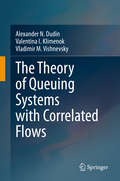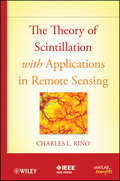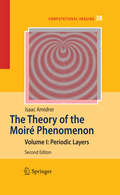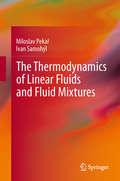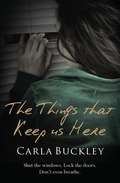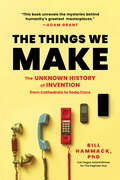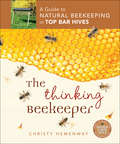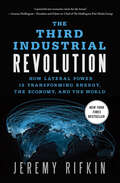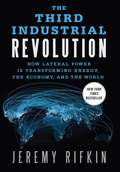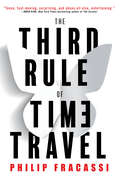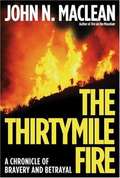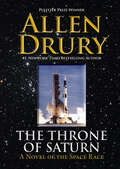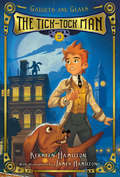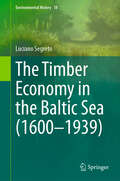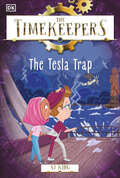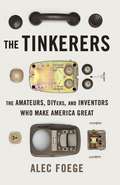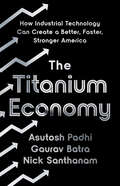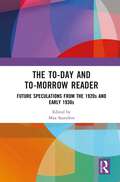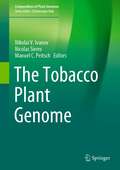- Table View
- List View
The Theory of Queuing Systems with Correlated Flows
by Alexander N. Dudin Valentina I. Klimenok Vladimir M. VishnevskyThis book is dedicated to the systematization and development of models, methods, and algorithms for queuing systems with correlated arrivals. After first setting up the basic tools needed for the study of queuing theory, the authors concentrate on complicated systems: multi-server systems with phase type distribution of service time or single-server queues with arbitrary distribution of service time or semi-Markovian service. They pay special attention to practically important retrial queues, tandem queues, and queues with unreliable servers. Mathematical models of networks and queuing systems are widely used for the study and optimization of various technical, physical, economic, industrial, and administrative systems, and this book will be valuable for researchers, graduate students, and practitioners in these domains.
The Theory of Scintillation with Applications in Remote Sensing
by Charles RinoIn order to truly understand data signals transmitted by satellite, one must understand scintillation theory in addition to well established theories of EM wave propagation and scattering. <P><P>Scintillation is a nuisance in satellite EM communications, but it has stimulated numerous theoretical developments with science applications. This book not only presents a thorough theoretical explanation of scintillation, but it also offers a complete library of MATLAB codes that will reproduce the book examples. The library includes GPS coordinate manipulations, satellite orbit prediction, and earth mean magnetic field computations. The subect matter is for EM researchers; however, also theory is relevant to geophysics, acoustics, optics and astoronomy.
The Theory of the Moiré Phenomenon
by Isaac AmidrorThis book presents the most comprehensive and methodical work on the theory of the moiré phenomenon, providing a full general-purpose and application-independent exposition of this fascinating effect. Based on the Fourier theory, it leads the reader through the various phenomena which occur in the superposition of repetitive layers, both in the image and in the spectral domains. The first chapters of the book present the basic theory, covering the superposition of monochrome, periodic layers. In later chapters, the theory is extended to the even more interesting cases of polychromatic moirés and moirés between repetitive, non-periodic layers. Throughout the whole text the book favours a pictorial, intuitive approach, which is supported by mathematics, and the discussion is accompanied by a large number of figures and illustrative examples. The prerequisite mathematical background is limited to an elementary familiarity with the Fourier theory.
The Thermoballistic Transport Model
by Reinhard Lipperheide Uwe WilleThe book presents a comprehensive survey of the thermoballistic approach to charge carrier transport in semiconductors. This semi-classical approach, which the authors have developed over the past decade, bridges the gap between the opposing drift-diffusion and ballistic models of carrier transport. While incorporating basic features of the latter two models, the physical concept underlying the thermoballistic approach constitutes a novel, unifying scheme. It is based on the introduction of "ballistic configurations" arising from a random partitioning of the length of a semiconducting sample into ballistic transport intervals. Stochastic averaging of the ballistic carrier currents over the ballistic configurations results in a position-dependent thermoballistic current, which is the key element of the thermoballistic concept and forms the point of departure for the calculation of all relevant transport properties. In the book, the thermoballistic concept and its implementation are developed in great detail and specific examples of interest to current research in semiconductor physics and spintronics are worked out.
The Thermodynamics of Linear Fluids and Fluid Mixtures
by Miloslav Pekař Ivan SamohýlIn this book, Samohýl and Pekař offer a consistent and general non-equilibrium thermodynamic description for a model of chemically reacting mixtures. This type of model is frequently encountered in practice and up until now, chemically reacting systems (out of equilibrium) have rarely been described in books on non-equilibrium thermodynamics. Readers of this book benefit from the systematic development of the theory; this starts with general principles, going through the applications to single component fluid systems, and finishing with the theory of mixtures, including chemical reactions. The authors describe the simplest mixture model – the linear fluid – and highlight many practical and thermodynamically consistent equations for describing transport properties and reaction kinetics for this model. Further on in the book, the authors also describe more complex models. Samohýl and Pekař take special care to clearly explain all methodology and starting axioms and they also describe in detail applied assumptions and simplifications. This book is suitable for graduate students in chemistry, materials science and chemical engineering as well as professionals working in these and related areas.
The Thermophysics of Porous Media (Monographs and Surveys in Pure and Applied Mathematics)
by T.J.T. SpanosModels for the mechanical behavior of porous media introduced more than 50 years ago are still relied upon today, but more recent work shows that, in some cases, they may violate the laws of thermodynamics. In The Thermophysics of Porous Media, the author shows that physical consistency requires a unique description of dynamic processes that involv
The Things That Keep Us Here: HOW DO YOU PROTECT YOUR FAMILY DURING A NATIONWIDE PANDEMIC?
by Carla BuckleyHOW DO YOU PROTECT YOUR FAMILY DURING A NATIONWIDE PANDEMIC?'The story of the Brooks family as they face a nationwide pandemic and fight to survive ... what an amazing read' Amazon reviewer 5 starsMillions are dead. Fear and panic have gripped the nation. An engrossing and emotionally gripping story of one family whose limits are tested to the extreme.It began with a dead bird. Then state-wide school closure. Before long, the whole town is in lockdown and the Brooks family are quarantined in their own home - with a faceless enemy on their doorstep.They must cope as best they can, battling hunger, cold and boredom. But as the threat inches closer, and neighbour turns against neighbour, single mother Ann doesn't know who she can trust - including those taking refuge in her house.With no end in sight, Ann knows that if she is to protect her daughters from untold danger, she must make impossible decisions in order to survive...
The Things We Make: The Unknown History of Invention from Cathedrals to Soda Cans
by Bill Hammack Ph.D.Discover the secret method used to build the world…For millennia, humans have used one simple method to solve problems. Whether it's planting crops, building skyscrapers, developing photographs, or designing the first microchip, all creators follow the same steps to engineer progress. But this powerful method, the "engineering method", is an all but hidden process that few of us have heard of—let alone understand—but that influences every aspect of our lives.Bill Hammack, a Carl Sagan award-winning professor of engineering and viral "The Engineer Guy" on Youtube, has a lifelong passion for the things we make, and how we make them. Now, for the first time, he reveals the invisible method behind every invention and takes us on a whirlwind tour of how humans built the world we know today. From the grand stone arches of medieval cathedrals to the mundane modern soda can, Hammack explains the golden rule of thumb that underlies every new building technique, every technological advancement, and every creative solution that leads us one step closer to a better, more functional world. Spanning centuries and cultures, Hammack offers a fascinating perspective on how humans engineer solutions in a world full of problems.Perfect for readers of Adam Grant and Simon Winchester, The Things We Make is a captivating examination of the method that keeps pushing humanity forward, a spotlight on the achievements of the past, and a celebration of the potential of our future that will change the way we see the world around us.
The Thinking Beekeeper: A Guide to Natural Beekeeping in Top Bar Hives (Mother Earth News Books for Wiser Living)
by Christy HemenwayA beginner&’s complete guide to keeping bees in top bar hives, and why. What&’s the buzz about the growing popularity of backyard beekeeping? Providing habitat for bees, pollinating your garden, and producing honey for your family are some of the compelling reasons for taking up this exciting hobby. But conventional beekeeping requires a significant investment and has a steep learning curve. The alternative? Consider beekeeping outside the box.The Thinking Beekeeper is the definitive do-it-yourself guide to natural beekeeping in top bar hives. Based on the concept of understanding and working with bees&’ natural systems as opposed to trying to subvert them, the advantages of this approach include:· Simplicity, sustainability, and cost-effectiveness · Increased safety due to less heavy lifting and hive manipulation · Chemical-free colonies and healthy hives Top bar hives can be located anywhere bees have access to forage, and they make ideal urban hives. Emphasizing the intimate connection between our food systems, bees, and the well-being of the planet, The Thinking Beekeeper will appeal to the new breed of beekeeper who is less focused on maximizing honey yield, and more on ensuring the viability of the bee population now and in the coming years.Mother Earth News Books for Wiser Living Recommendation&“You&’ll find information you need here that&’s not available anywhere else. Both you and your bees will benefit from Christy&’s approach, advice, and philosophy.&” —Kim Flottum, editor, Bee Culture Magazine&“A unique and exceptional resource for the beginning beekeeper.&” —Marty Hardison, top bar beekeeper, educator and international developmental beekeeping consultant
The Third Industrial Revolution: How Lateral Power Is Transforming Energy, the Economy, and the World
by Jeremy RifkinA New York Times–bestselling account of the next great economic era, with a look into the individuals pioneering its implementation around the world.One of the most influential social thinkers of our time reveals how Internet technology and renewable energy are merging to create the new jobs of the twenty-first century and change the world.In The Third Industrial Revolution, Jeremy Rifkin takes us on a journey into a new economic era where hundred of millions of people produce their own green energy in their homes, businesses, and factories and share it with each other on an “energy Internet.” Rifkin’s Third Industrial Revolution vision has been taken up by the European Union and China and endorsed by the United Nations. In this book, the author goes behind the scenes to meet the heads of state, global CEOs, social entrepreneurs, and NGO leaders who are pioneering the new economic paradigm.Praise for The Third Industrial Revolution“Jeremy Rifkin argues that green energy and the internet will revolutionize society and the environment . . . With the European Union already on board, this is a big idea with backbone.” —Nature“Impeccably argued . . . a compelling and cogent argument to overhaul our society and economy in favor of a distributed and collaborative model.” —Publishers Weekly
The Third Industrial Revolution: How Lateral Power is Transforming Energy, the Economy, and the World
by Jeremy RifkinThe Industrial Revolution, powered by oil and other fossil fuels, is spiraling into a dangerous endgame. The price of gas and food are climbing, unemployment remains high, the housing market has tanked, consumer and government debt is soaring, and the recovery is slowing. Facing the prospect of a second collapse of the global economy, humanity is desperate for a sustainable economic game plan to take us into the future. Here, Jeremy Rifkin explores how Internet technology and renewable energy are merging to create a powerful "Third Industrial Revolution. " He asks us to imagine hundreds of millions of people producing their own green energy in their homes, offices, and factories, and sharing it with each other in an "energy internet," just like we now create and share information online. Rifkin describes how the five-pillars of the Third Industrial Revolution will create thousands of businesses, millions of jobs, and usher in a fundamental reordering of human relationships, from hierarchical to lateral power, that will impact the way we conduct commerce, govern society, educate our children, and engage in civic life. Rifkin's vision is already gaining traction in the international community. The European Union Parliament has issued a formal declaration calling for its implementation, and other nations in Asia, Africa, and the Americas, are quickly preparing their own initiatives for transitioning into the new economic paradigm. The Third Industrial Revolutionis an insider's account of the next great economic era, including a look into the personalities and players - heads of state, global CEOs, social entrepreneurs, and NGOs - who are pioneering its implementation around the world.
The Third Rule of Time Travel
by Philip FracassiRule One: You can only travel to a point within your lifetime.Rule Two: You can only travel for ninety seconds.Rule Three: You can only observe.The rules cannot be broken. In this electrifying science fiction thriller from acclaimed author Philip Fracassi, a scientist has unlocked the mysteries of time travel. This is not the story you think you know. And the rules are only the beginning. "Tense, fast-moving, surprsing, and above all else, entertaining." – Owen King, New York Times bestselling author "A clever premise digs its heels into a sci-fi thriller that breaks into a fast gallop from the first page – exciting, haunting, compelling stuff." – Chuck Wendig, author of The Book of Accidents Scientist Beth Darlow has discovered the unimaginable. She's built a machine that allows human consciousness to travel through time—to any point in the traveler's lifetime—and relive moments of their life. An impossible breakthrough, but it's not perfect: the traveler has no way to interact with the past. They can only observe. After Beth's husband, Colson, the co-creator of the machine, dies in a tragic car accident, Beth is left to raise Isabella—their only daughter—and continue the work they started. Mired in grief and threatened by her ruthless CEO, Beth pushes herself to the limit to prove the value of her technology. Then the impossible happens. Simply viewing personal history should not alter the present, but with each new observation she makes, her own timeline begins to warp. As her reality constantly shifts, Beth must solve the puzzles of her past, even if it means forsaking her future."Part Crichton, part Bradbury, and all Fracassi, The Third Rule of Time Travel further demonstrates why Fracassi is one of the best writers working today, regardless of genre." – Tyler Jones, author of Midas
The Third Wave
by Alvin TofflerThe Third Wave offers a striking way out of today's despair...a bracing, optimistic look at our new potentials. The Third Wave makes startling sense of the violent changes now battering our world. Its sweeping synthesis casts fresh light on our new forms of marriage and family, on today's dramatic changes in business and economics. It explains the role of cults, the new definition of play, love and success. It points toward new forms of twenty-first-century democracy.
The Thirtymile Fire: A Chronicle of Bravery and Betrayal
by John N. MacleanThe Thirtymile Fire in the North Cascade Range near the Canadian border of Washington began as a simple mop-up operation; in a few hours, a series of catastrophic errors led to the entrapment and deaths of four members of the fire crew--two teenage girls and two young men. Each had brought order and meaning to their lives by joining the fire world. Then the very flames they pursued turned on them, extinguishing their lives. When the victims were blamed for their own deaths, the charge brought a storm of controversy that undermined the firefighting community. Continuing a tradition established by his previous books, and by his father Norman's Young Men and Fire, John Maclean re-creates the harrowing few minutes when the rogue wildfire burst out of a remote canyon to trap the surprised firefighters. Maclean's unflinching analysis exposes the details of the fire's unexpected violence--which is matched by the passions released by the official verdict of the blaze. Weaving together the astonishing stories told by the fire's witnesses and, later, the victims' family members and the response to the official reports, Maclean creates a telling narrative of a catastrophe that continues to divide a community. He also offers new information that could help to prevent such tragedies in the future. Even though the Thirtymile Fire is changing the way fire is fought, the author believes the fire world has been slow to adopt flexible field-tested procedures over traditional firefighting rules and regulations. "Fire has a life of its own beyond scientific absolutes," Maclean writes. It's deadly and unpredictable. The biggest unsolved mystery of the Thirtymile Fire concerns its erratic behavior. Why did it take that tragic left hook, entrapping four youths on that fateful July day? It's a question that will haunt readers of this dramatic true story.
The Threshold: Leading in the Age of AI
by Nick ChatrathAccomplished leadership consultant Nick Chatrath offers a revolutionary framework for how leaders in all kinds of organizations can adapt to the new age of technology, like ChatGPT—the Age of AI— by leaning into the qualities and skills that make us uniquely human. For readers of Yuval Noah Harari’s 21 Lessons for the 21st Century and Max Tegmark’s Life 3.0, The Threshold is a bold new way to think about human, emotionally intelligent leadership right now as we stand at the threshold of AI superintelligence.We are living in a new age: the Age of AI. With developments emerging every day, Artificial Intelligence will soon surpass most human competencies, and as a result drastically transform technology’s role in our day-to-day world. The solution for organizational leaders is not to become more like computers. In order for our organizations to survive as we stand at the threshold of a new era, we must tap into the qualities that make us uniquely human.In the face of increasingly intelligent technology, old models of leadership are becoming obsolete. In The Threshold: Leading in the Age of AI, accomplished leadership consultant Nick Chatrath interweaves an analysis of antiquated leadership models—the ones that leave AI-Era organizations exposed and ineffective with colleagues frustrated, unmotivated, and burnt-out—with his newly developed strategies for more effective “threshold” leadership methods. Supported with anecdotes, research, and a practical toolkit, The Threshold demonstrates that adaptive, effective organizations can be built with human, emotional intelligence: cultivating stillness, nurturing independent thinking, finding rhythms of rest and performance, and raising leadership consciousness. With a basis in the ideas and practices that have shaped our organizations in the past, The Threshold illuminates how accessing advanced stages of human development can be both competitive and harmonious with AI’s growing insinuation into our working world.
The Throne of Saturn: A Novel of the Space Race
by Allen DruryMaster novelist Drury probes the controversy and political machinations as America strives to land on Mars . . .A mission that may be torn apart by the nation&’s turmoil . . .The Throne of Saturn shows the struggle of dedicated and courageous astronauts to set foot on the red planet and maintain our quest for the stars
The Tick-Tock Man
by James Hamilton Kersten HamiltonWally and Noodles are back to the business of scientific innovation--and fun. In London, they meet a young pickpocket named Dobbin who works for a mysterious criminal called the Tick-Tock Man. Soon they are racing through secret tunnels in a bid to help Dobbin's little sister. Can the brave boy-scientist and his loyal sidekick find the one person who can save her before it's too late? History and technology collide in this humorous series brimming with mad science.
The Timber Economy in the Baltic Sea (Environmental History #18)
by Luciano SegretoThis monograph puts a focus on the fundamental role of timber, in the European industrialization process. This ties into analyzing the early stages of globalization, which often solely revolves around the flow of capital. While this is also discussed in this book, the author paints a more complex picture of international trade, and particularly the relationships between the countries producing commodities and the consumer countries. Throughout the chapters, readers will get an understanding of the organization behind the timber value chain from the forests of Central Eastern Europe, the main Scandinavian countries, and Russia, to the main consumer markets in Western Europe. The examined time frame is between the end of the 17th century and World War 2. During that time, a fascinating nexus of economic, technological, and financial structures evolved, that tied the forests’ areas to the consumption centres – with the help of Baltic merchants. It is a fascinating story that ties together historical information for readers interested in economic history and traditional use of forest products.
The Timekeepers: The Tesla Trap (Timekeepers )
by SJ KingThe Timekeepers are a secret organization of kids who keep the course of history on track. And history needs them—a villain called DeLay is causing chaos!When the hands on their watches start to spin backward, the Timekeepers know that DeLay has been up to no good, and it's up to them to put things right...In this installment, the Timekeepers travel back to 1890s New York City and the laboratory of Nikola Tesla. On the eve before Tesla is set to reveal his latest invention, the X-Ray Machine, the time pirate DeLay, disguised as Tesla's rival Thomas Edison, steals the machine. The Timekeepers begin a pursuit around New York City in search of the machine to ensure history stays on track. With a range of adventures that span all of history, The Timekeepers series is perfect for any adventure lover.
The Tinkerers: The Amateurs, DIYers, and Inventors Who Make America Great
by Alec FoegeHaving completed her transition from a manufacturing economy, America - it is said - has stopped making things. When there are breakthroughs in engineering and design, it's usually thanks to a team of corporate researchers trying to squeeze out more profit. But once upon a time, the United States was a nation of tinkerers. Amateurs and professionals alike applied their ingenuity and talent to the problems of their day, coming up with innovative solutions that at once channeled the optimistic spirit of America and kept that spirit alive. Guided by the curiosity of an inquiring mind, a desire to know how things work, and a belief that anything can be improved, they laid the foundations for the American century.When Alexander Graham Bell beat Thomas Edison to the invention of the telephone, Edison fiddled around with the transmitter and receiver until he produced an equally revolutionary machine - the phonograph. When Thomas MacDonald observed the hardship that a lack of good roads imposed on his fellow Iowans, he began a road-building project that eventually morphed into the interstate highway system. Some of the people profiled in this book attended the finest engineering schools in the world; some, like Microsoft's former chief technology officer Nathan Myhrvold, had no formal training in their chosen fields. Some see themselves as solo visionaries; others emphasize the importance of working in teams. What binds them together is an ability to imagine new systems and subvert old ones, to see fresh potential in existing technologies, and to apply technical know-how to the problems of their day.In The Tinkerers, Alec Foege presents a version of American history told through feats of engineering, large and small. He argues that reports of tinkering's death have been greatly exaggerated; since World War II, it has been the guiding force behind projects from corporate-sponsored innovations (the personal computer, Ethernet) to smaller scale inventions with great potential (a machine that can make low-cost eyeglass lenses for people in impoverished countries, a device that uses lasers to shoot malarial mosquitoes out of the sky). Think tanks and companies have recognized the benefits of tinkering and have done their best to harness and institutionalize it. But as systems become more complex, budding inventors may become intimidated. Foege argues that this would be an enormous loss to a nation that achieved its strength largely thanks to the accomplishments of its innovators. He shows us how tinkering remains, in new and unexpected forms, at the heart of American society and culture.
The Titanium Economy: How Industrial Technology Can Create a Better, Faster, Stronger America
by Asutosh Padhi Gaurav Batra Nick SanthanamA Wall Street Journal bestseller The future of the American economy is hiding in an unlikely place: the manufacturing sector While Silicon Valley titans dominate headlines, many of the fastest-growing, most profitable companies in the United States are firms you&’ve likely never heard of, such as HEICO, Trex, and Casella. These booming companies belong to a burgeoning sector—industrial tech—that offers surprising hope to workers, consumers, and investors alike. Their role: to make a range of products—aerospace parts, for example, or recycled plastic lumber—that quietly form the backbone of America&’s biggest industries. In an age of instability, industrial tech is a cornerstone of our economic future. In this book, McKinsey veterans Asutosh Padhi, Gaurav Batra, and Nick Santhanam reveal the &“titanium economy,&” a modern, reinvented industrial sector complete with high-paying, domestic jobs;, soaring stock prices;, and critical infrastructure. They dispel the myth that the best of American manufacturing is behind us and illuminate an opportunity for a brighter future—if we can seize it.
The To-day and To-morrow Reader: Future Speculations from the 1920s and Early 1930s
by Max SaundersThe To-day and To-morrow book series (1923–1931) was a unique publishing phenomenon – over 100 short, often brilliant, books choosing a particular subject, outlining its present state, and then speculating about its future. This Reader brings together some of the best work in the series, including eleven complete volumes and substantial extracts from ten more.To-day and To-morrow is one of the key documents of modernity. It contains some of the best writing of the twentieth century, and some of the most visionary predictions. The contributors were creative writers, scientists, inventors, philosophers, lawyers, doctors, and teachers. Included here are Bertrand Russell, Vera Brittain, Sarvepalli Radhakrishnan, Robert Graves, and the scientists J. B. S. Haldane, J. D. Bernal, and Sir James Jeans. The topics range from emerging technologies such as the talkies, television, robotics, and drones, to speculations about future technologies like test-tube babies, artificial wombs, cyborgs, genetic modification, hormone replacement therapy, space exploration, the internet, and the possibility of hive minds. The books consider how societies will respond to such developments; how the transformations will impact on lives, relationships, beliefs, politics.To-day and To-morrow brings new perspectives to the literature and culture of modernism and modernity for general readers, students, and scholars. It sheds new light on twentieth-century literature, culture, and society. It offers resources for teachers and students of creative writing – and everyone – facing the challenge of thinking about our future.
The Tobacco Plant Genome (Compendium of Plant Genomes)
by Manuel C. Peitsch Nikolai V. Ivanov Nicolas SierroThis book describes the history of tobacco genomics, from its “discovery” by Europeans to next-generation omics approaches in plant science. The authors primarily focus on the allotetraploid common tobacco plant (N. tabacum); however, separate chapters are dedicated to closely related Nicotiana species, such as N. benthamiana and N. attenuata, for which substantial progress in omics data analysis has been already achieved. While genetic maps, transcriptomes, and physical maps of BAC libraries have significantly enhanced our understanding of the tobacco plant, the genome of tobacco and related Nicotiana species has opened a new era in modern tobacco research. This book addresses current and future industrial and research applications as well as central challenges in tobacco science, including diseases, low variability of cultivars, the genome’s large size, polyploidy, and gene duplication.
The Toilet Papers
by Sim Van der RynA classic is back in print! One of the favorite books of 1970s back-to-the-landers, The Toilet Papers is an informative, inspiring, and irreverent look at how people have dealt with their wastes through the centuries. In a historical survey, Van der Ryn provides the basic facts concerning human wastes, and describes safe designs for toilets that reduce water consumption and avert the necessity for expensive and unreliable treatment systems. The Toilet Papers provides do-it-yourself plans for a basic compost privy and a variety of graywater systems.
The Tomorrow File, The Passion of Molly T., and Capital Crimes: The Tomorrow File, The Passion of Molly T., and Capital Crimes
by Lawrence SandersThree gripping thrillers with settings ranging from a terrifying dystopia to a politically charged college campus, from the bestselling creator of the Edward X. Delaney Series. In the future, the government controls every aspect of its citizens' lives, from their gender and their genes to where they work, what they eat, and how they love. The Tomorrow File tells the story of what happens to utopia when people get fed up with pleasure, and stand up to fight for their right to live how they choose--and die for what they believe in. Activism runs rampant on the college campus where young Molly Turner seeks vengeance after her radical feminist girlfriend is killed by homophobic bigots. In The Passion of Molly T., there is a fine line between justice and mayhem. His name is Brother Kristos, and to the president of the United States, he is a savior, a holy man who has been able to do something no doctor could manage: heal the president's son. But as the president relies more and more on the mystic, the country slips toward chaos--and the explosive finale of Capital Crimes. These three novels from "master of suspense" Lawrence Sanders (TheWashington Post) show the world on the brink of disaster. Whether set in the distant future or the here and now, the thrillers in this three-volume omnibus will prove impossible to put down.
